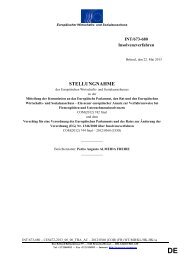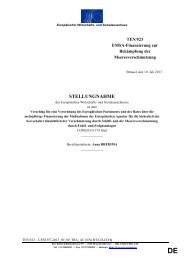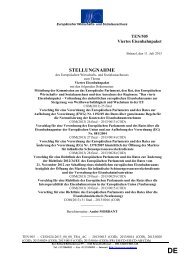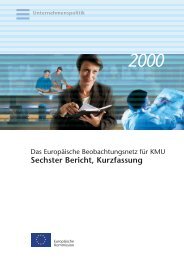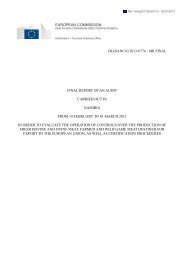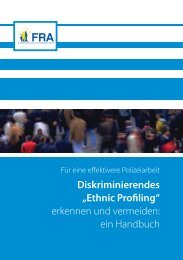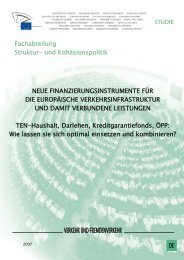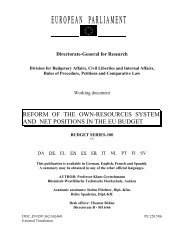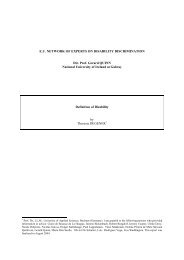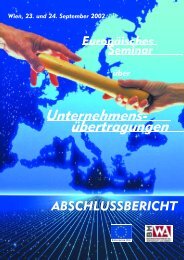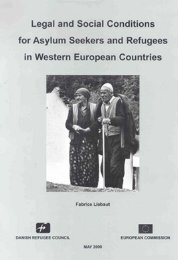processi estensivi di depurazione delle acque reflue guid a
processi estensivi di depurazione delle acque reflue guid a
processi estensivi di depurazione delle acque reflue guid a
You also want an ePaper? Increase the reach of your titles
YUMPU automatically turns print PDFs into web optimized ePapers that Google loves.
INDICE<br />
Page<br />
◗ LO SCOPO DI QUESTA GUIDA 2<br />
◗ IL QUADRO NORMATIVO E L'INCENTIVO 3<br />
DELL'UNIONE EUROPEA<br />
PER LA REALIZZAZIONE DI INFRASTRUTTURE DI RACCOLTA<br />
E DI TRATTAMENTO DELLE ACQUE REFLUE URBANE<br />
➜ Le scadenze 3<br />
➜ Gli obiettivi da raggiungere per sod<strong>di</strong>sfare le <strong>di</strong>sposizioni della <strong>di</strong>rettiva 3<br />
◗ LE TECNICHE APPLICABILI 4<br />
PER RISPETTARE LE PRESCRIZIONI DELLA DIRETTIVA<br />
➜ Le tecniche intensive classiche 4<br />
▲ Letti percolatori<br />
▲ Dischi biologici<br />
▲ Fanghi attivi<br />
▲ Vantaggi ed inconvenienti <strong>delle</strong> varie tecniche intensive<br />
➜ Le tecniche estensive 8<br />
◗ PROCESSI ESTENSIVI: SCHEDE TECNICHE 9<br />
➜ Colture su supporto fine 9<br />
▲ Funzionamento: i meccanismi in atto<br />
▲ Infiltrazione-percolamento su sabbia<br />
▲ Filtrazione con piante a deflusso verticale<br />
▲ Filtrazione con giunchi a deflusso orizzontale<br />
➜ Colture libere 16<br />
▲ Funzionamento: i meccanismi in atto<br />
▲ Lagunaggio naturale<br />
▲ Lagunaggio aerato<br />
◗ CONCLUSIONI: ALCUNI ELEMENTI PER LE SCELTE TECNICHE 23<br />
➜ Riepilogo <strong>delle</strong> tecniche estensive 23<br />
➜ Qualità degli scarichi 23<br />
➜ Vantaggi ed inconvenienti: riepilogo 24<br />
➜ L’importanza del fattore climatico 25<br />
➜ Albero decisionale 25<br />
➜ I costi 26<br />
➜ Il vantaggio dei <strong>processi</strong> <strong>estensivi</strong>: il contributo ambientale 26<br />
◗ ALLEGATI: LO STUDIO DEI CASI 27<br />
➜ Infiltrazione percolamento: 27<br />
un caso particolare, l’impianto <strong>di</strong> Mazagon (Spagna)<br />
➜ Infiltrazione percolamento: 29<br />
un impianto classico, il caso <strong>di</strong> Souillac Paille-Basse (Francia – Dipartimento del Lot)<br />
➜ Filtri con piante a deflusso verticale: 30<br />
il caso <strong>di</strong> NEA Madytos – Mo<strong>di</strong> (Grecia)<br />
➜ Sistema ibrido: 32<br />
(filtri con piante a deflusso verticale e filtri con piante a deflusso orizzontale):<br />
il caso <strong>di</strong> Oaklands Park, Newnham-on-Severn, Gloucestershire (Regno Unito)<br />
➜ Lagunaggio naturale: 34<br />
il caso dell’impianto <strong>di</strong> Vauciennes (Francia – Oise)<br />
➜ ¸Lagunaggio aerato: 36<br />
il caso dell'impianto <strong>di</strong> A<strong>di</strong>nkerke (Belgio)<br />
◗ GLOSSARIO 38<br />
◗ BIBLIOGRAFIA 40<br />
Jean-Marc BERLAND (OIEau), Catherine BOUTIN (CEMAGREF), Pascal MOLLE (CEMAGREF) e Paul COOPER (Consulente in<strong>di</strong>pendente)<br />
hanno curato la redazione della presente <strong>guid</strong>a.<br />
Jean-Antoine FABY (OIEau), Pascal MAGOAROU (Commissione Europea) e Jean DUCHEMIN (Commissione Europea) hanno curato<br />
la sezione scientifica e tecnica e apportato contributi precisi.<br />
Luca MARNO (Commissione Europea -- DG Ambiente) ha convalidato la versione italiana <strong>di</strong> questa <strong>guid</strong>a.



